What is the Difference Between Running and Walking Shoes? – Stop Buying the Wrong Type of Shoes for Your Kid
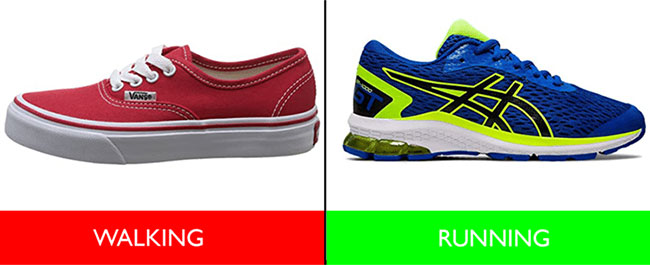
As a children’s shoe fitter with over a decade of experience, I’ve seen many kids wear the wrong shoes for the wrong activities—especially when it comes to running versus walking. While these shoes may look alike, they’re designed for very different movements and impact levels. In this guide, I’ll break down the key differences between running and walking shoes for kids, and share my top picks for versatile styles that support both. Choosing the right type of shoe can prevent discomfort, injuries, and support your child’s foot health as they grow.
Do You Need to Buy Two Different Sets of Shoes?
You don’t need to buy separate shoes for walking and running—running shoes are versatile enough to handle both. While they may look similar, running and walking shoes serve different functions, as your child’s feet hit the ground differently with each activity. That’s why it’s important to choose a shoe that’s specifically designed to absorb higher impact and support natural movement—making running shoes the smarter, all-purpose choice.
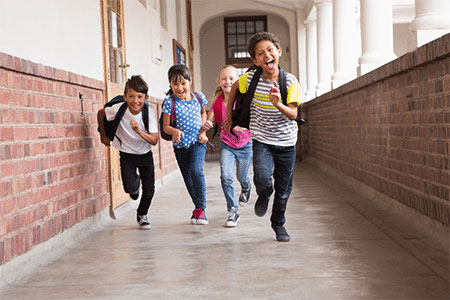
What is the Difference Between Running and Walking Shoes?
Here’s the key difference: Running shoes are versatile—they’re designed to handle both running and everyday walking. Walking shoes, on the other hand, are built solely for low-impact movement and don’t offer the support or shock absorption needed for running or high-impact play.

Running Shoes: Engineered for High Impact
Running shoes are designed to handle the intense impact that comes with running. The repetitive motion of running puts significant stress on the feet, requiring shoes that provide ample cushioning and support. This cushioning helps absorb shocks, protecting growing feet from potential damage. Additionally, running shoes often feature designs that enhance performance, such as lightweight materials and advanced traction systems.
Walking Shoes: Crafted for Comfort and Flexibility
Walking shoes, on the other hand, prioritize comfort and flexibility. Even though walking is a low-impact activity, it still requires proper support to maintain healthy foot development. Everyday shoes are designed to accommodate the natural heel-to-toe motion, offering a more flexible structure that supports movement without restricting it. They are typically more versatile, making them suitable for various casual activities beyond walking.
Getting Your Child’s Accurate Foot Size
Ensuring your child is wearing the right size is critical for comfort and health. An ill-fitting shoe can lead to discomfort and long-term foot issues. Knowing how to accurately measure your child’s foot size is essential, especially when ordering shoes online or selecting from a wide range of brands.

Virtual Shoe Fitting Service: Convenience and Accuracy
I created a virtual shoe fitting service to help you accurately measure your child’s foot size from the comfort of your home. In the guide, I show you how to determine your child’s exact length, width (narrow to extra wide), and whether they have a high instep—so you can find shoes that truly fit.
Now that you understand the key differences between running and walking shoes—and know how to accurately measure your child’s foot size at home—you’re ready to explore my top picks for the best running shoes for kids. Disclosure: Some links are affiliate links, meaning we may earn a small commission at no extra cost to you.
Best Running Shoes for Kids – Better Support and Stability
In 2025, several brands have excelled in creating running shoes for kids that combine comfort, support, and durability. Some children may have narrow or wide feet, flat arches, or high insteps. Understanding your child’s foot shape helps in selecting shoes that align with their natural foot structure.
1. Shoe Style GT-1000 by Asics
These Asics running shoes for kids offer a snug, secure fit with lightweight cushioning and excellent support—perfect for active children with narrow to medium-width feet.

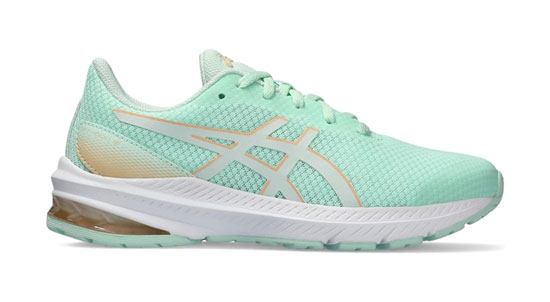
Key Features
- Order the shoe GT-1000 by Asics on Zappos or Amazon
- Fits narrow or medium feet
- Available for little and big kids
- GEL technology: Improves impact absorption and creates a softer feeling at footstrike
- I suggest that you get this shoe a whole size larger than your child’s current foot size
2. Shoe Style Fresh Foam 625 by New Balance
These New Balance running shoes for kids are perfect for kids who need a reliable all-around shoe, capable of supporting diverse sports engagements.
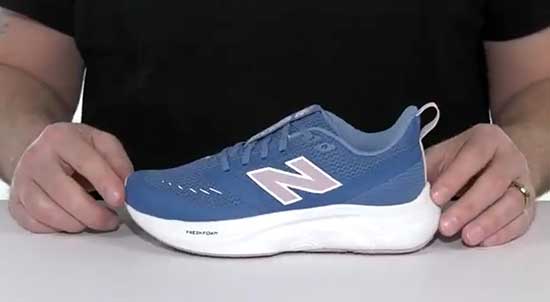

Key Features
- Order the shoe Fresh Foam 625 by New Balance on Amazon or the New Balance website
- Fits medium, wide, or extra wide feet
- Fresh Foam midsole cushioning provides an ultra-cushioned, lightweight ride
- Padded collar and tongue
- I suggest that you get this shoe a half size larger than your child’s current foot size
3. Shoe Style Gel-Noosa by Asics
These Asics athletic shoes are a popular choice for their vibrant colors and appealing design.

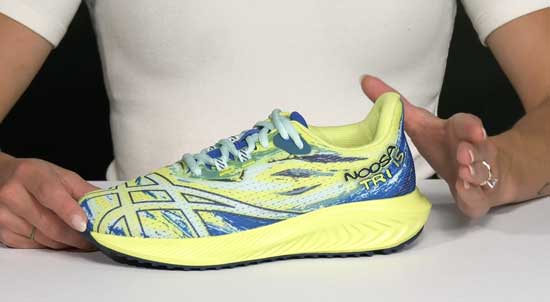
Key Features
- Order the shoe Gel-Noosa by Asics on Amazon or Zappos
- Fits narrow or medium feet
- Available for little and big kids
- Stitched toe and solid rubber outsole to improve durability
- I suggest that you get this shoe a whole size larger than your child’s current foot size
4. Shoe Style Assert 10 by Under Armour
These red Under Armour shoes for kids are lightweight, supportive, and have a cushioned sole that provides all-day comfort and stability.
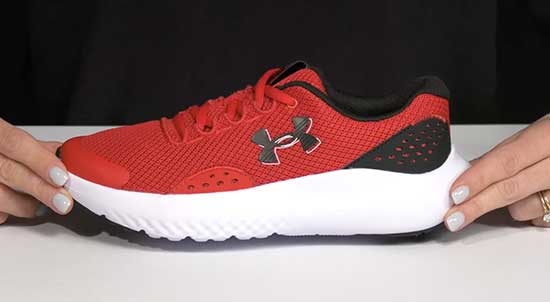
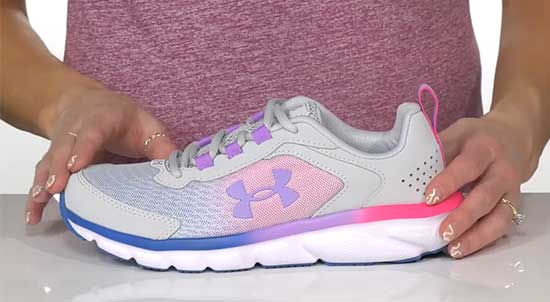
Key Features
- Order the shoe Assert 10 by Under Armour on Amazon or Zappos
- Fits narrow or medium feet
- Available for little and big kids
- One-piece EVA midsole that transforms cushioned landings into explosive takeoffs
- I suggest that you get this shoe a whole size larger than your child’s current foot size
5. Shoe Style Mach by Hoka
These Hoka running shoes for kids provide a plush midsole with superior shock absorption, while the lightweight design ensures ease of movement.

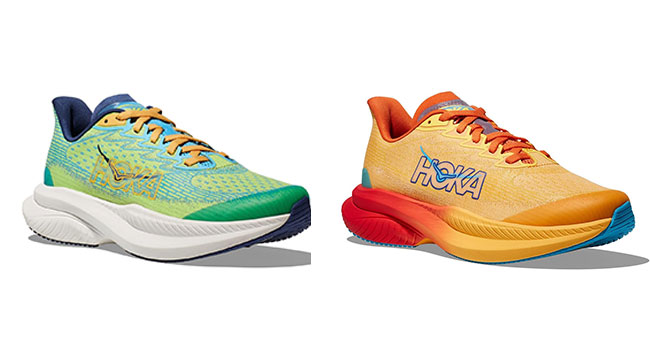
Key Features
- Order the shoe Mach by Hoka on Amazon or Zappos
- Fits medium or wide feet
- Available for big kids
- Cushioned midsole for shock absorption
- Durable outsole with excellent traction
- Ideal for children who need extra support from their shoes
- I suggest that you get this shoe a half size larger than your child’s current foot size
6. Shoe Style 1906 by New Balance
These are some of the best running shoes for kids and they offer a blend of style and functionality.
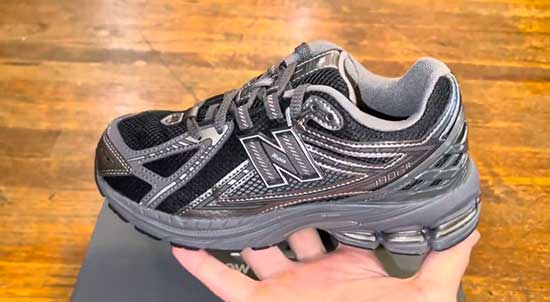
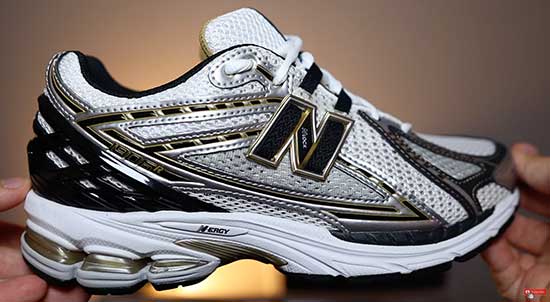
Key Features
- Order the shoe 1906 by New Balance on the New Balance website
- Fits medium or wide feet
- ABZORB midsole absorbs impact through a combination of cushioning and compression
- Padded collar and tongue
- I suggest that you get this shoe a half size larger than your child’s current foot size
7. Shoe Style Kinvara by Saucony
These Saucony running shoes are lightweight and offer excellent cushioning and flexibility. It’s perfect for kids who enjoy running and other high-impact activities.
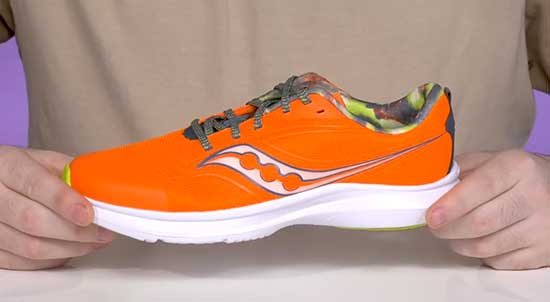

Key Features
- Order the shoe Kinvara by Saucony on Amazon
- Fits medium or wide feet
- Foam padding placed around the ankle collar and under the tongue
- Comfort sockliner molds to your foot with padding in the heel for ultimate cushioning at heel-strike
- Engineered mesh for structure, stretch and enhanced breathability
- I suggest that you get this shoe a half size larger than your child’s current foot size
8. Shoe Style Contend by Asics
These Asics running shoes are known for their durability and support. Designed for active kids, these shoes offer a snug fit with a narrow heel counter.
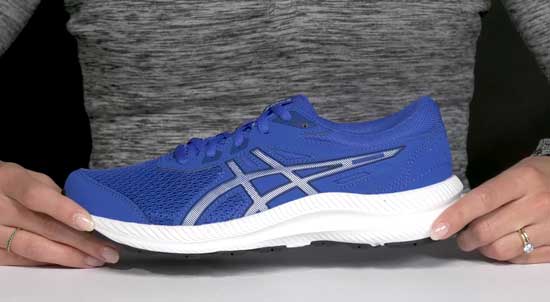
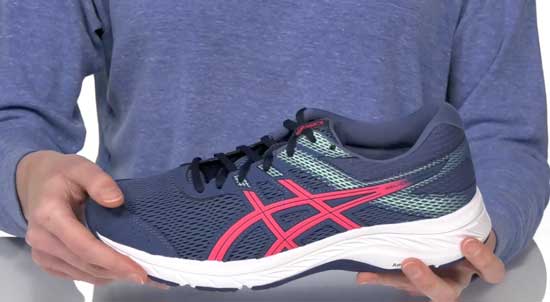
Key Features
- Order the shoe Contend by Asics on Amazon
- Fits narrow or medium feet
- The toe reinforcement, toe rubber stitching, and solid rubber outsole improve durability
- I suggest that you get this shoe a whole size larger than your child’s current foot size
9. Shoe style Fresh Foam X 1080v13 by New Balance
These New Balance wide kids’ running shoes offer plush cushioning, a supportive heel, and a smooth ride to keep growing feet comfortable and protected all day.
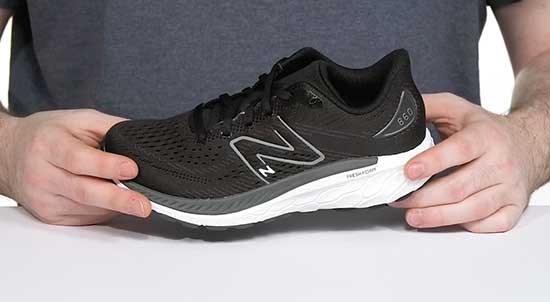
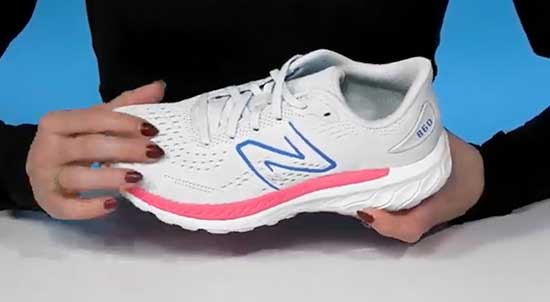
Key Features
- Order the shoe Fresh Foam X 1080v13 by New Balance on Amazon or the New Balance website
- Fits children with medium or wide feet
- Lace-up closure
- Suede and mesh upper
- I suggest that you get this shoe a half size larger than your child’s current foot size
10. Shoe Style Gel-Excite by Asics
These kids’ Asics running shoes feature a narrow design, making them suitable for children with slim feet.

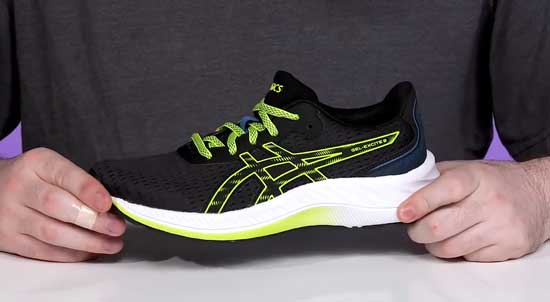
Key Features
- Order the shoe Gel-Excite by Asics on Amazon
- Fits narrow or medium feet
- GEL technology: Improves impact absorption and creates a softer feeling at footstrike
- I suggest that you get this shoe a whole size larger than your child’s current foot size
Bonus Resources: Running Shoes for “Complicated” Foot Shapes
Finding the right running shoes for children with unique foot shapes—whether narrow or wide—can be tricky. For kids with narrow feet, choose brands that offer narrow-width options to ensure a secure, slip-free fit. For wide feet, look for shoes with a roomy toe box that allows the toes to spread naturally, helping prevent pinching, blisters, and discomfort. The right fit makes all the difference in comfort, performance, and foot health.
Personalized Recommendations
For specific shoe recommendations tailored to your child’s unique foot shape, feel free to contact me via email or through the comments section below. Together, we can ensure your child steps into the right pair of shoes with confidence. Personalized advice can make all the difference in selecting the perfect shoe for your child.
What Are the Best Running Socks for Kids?
Pairing the right socks with running shoes can enhance comfort and prevent blisters. Socks that wick moisture away from the skin help in keeping feet dry and comfortable. These socks prevent the buildup of sweat, reducing the risk of blisters and irritation. Look for materials like merino wool or synthetic blends designed for moisture management.
1. Nike Kids’ Everyday Cushion Crew Socks
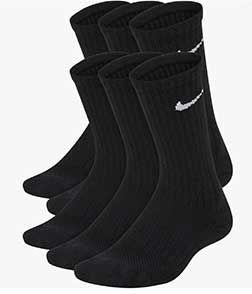
- Order these socks made by Adidas on Amazon
- Dri-FIT fabric and spandex for a comfortable secure fit
- Strategically placed cushions target key impact areas
- Mesh fabric enhances ventilation
2. Adidas Youth Athletic Cushioned Crew Socks
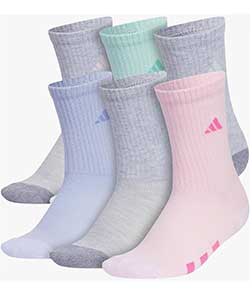
- Order these youth athletic cushioned crew socks by Adidas on Amazon
- 96% Polyester, 4% Spandex
- Cushioned heel and toe for comfort
- Size callout added to the bottom of the foot
- Moisture-wicking yarn keeps feet dry from sweat
3. New Balance Girls’ Performance Cushioned Low Cut
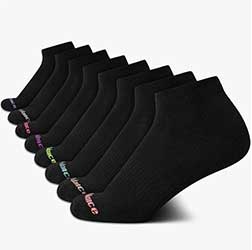
- Order these socks made by New Balance on Amazon
- 97% Polyester, 3% Spandex
- Moisture-wicking technology and knit-in vents help to keep feet cool and dry
- Seamless toe closure is designed to minimize friction
4. New Balance Youth Active Low Cut Socks

- Order these low cut Socks socks made by New Balance on the New Balance website
- Anti-odor and anti-bacterial technology
- Comfortable cushioned footbed
- NB DRY fast-drying technology wicks moisture away
Did you know your child’s feet naturally swell throughout the day from all the walking, running, and standing they do? That’s why it’s best to have them try on new shoes in the late afternoon or evening—when their feet are at their largest—to ensure all-day comfort and the perfect fit.


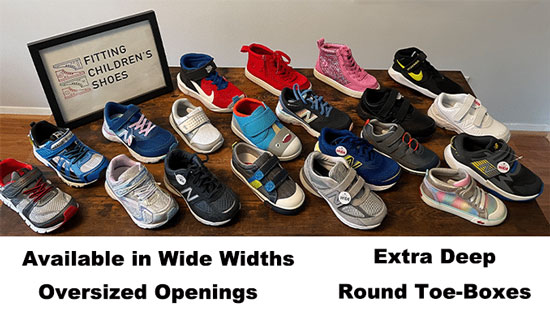

Great post! thanks for sharing
So so important to get your kid’s shoes right. I never ever skimp on shoes. I make sure I have the good running shoe for my kids to wear to school. One of my 14 yr old twins has a size 15 so it is really important he has the right shoe for whatever activity he is doing. I even bought basket ball shoes that he can only wear on the wooden boards.
And they also have their good black shoes for school. There is nothing worse that seeing a kid with oversized runners or the wrong footwear for running and playing!!!
I agree Sharon! I am sure you find it hard to find shoes for your son… I haven’t met a lot of children with that shoe size!And maybe, he is still growing… Good luck with that!
Please let me know anytime you have questions about a particular shoe style.
I got my son the pair of Aiscs you recommend and he loooves it! He runs so much and is involved in track. He always complained about his feet and legs hurting after doing exercise. Now he doesn’t anymore!
You are a life saver! I am bookmarking your website! Thank you!
Sharon,
You are welcome!!! Let me know anytime you might have a specific question!
Very interesting article to be conscious about our children health.
I never took the time to think what kind of shoes were my kids wearing. I just buy them the ones they like. Now that I read this I think I’m doing something wrong..
My child has a very wide feet do you know which shoes will fit him better?
Kevin,I wrote a post about the best shoes for wide feet. If your child has a wide or extra wide foot, you will probably benefit from reading it. The post’s name is:
Extra Wide Shoes for Children
Socks for Wide Feet – The Best Wide Socks for Kids
Since the feet of our kids are growing and forming, the proper foot protection is important and crucial. My son has the widest feet, so I ordered the New Balance pair. He loved it, he said its the most comfortable shoe he has ever worn!! Thank you! Besides children, this post is good for adults too.
Billy,
New Balance tends to make the widest shoes, with the roundest toe-boxes. Saucony also makes shoes in wide and extra wide widths. I am glad your child is happy about his new shoes!
I’m glad you mentioned that I don’t have to invest in two different types of sneakers for my kids as I’m on a budget! We do a lot more walking than running so I guess walking shoes will be my priority. The only problem with buying shoes online is the fit as we can’t try them on personally. Any suggestions on this?
Yvonne,
Is there a local shoe store in your area you can take your kids’ to have their feet properly measured? it is hard buying shoes online if you don’t know what you are looking for. If there is a particular style you like, I can tell you how the shoe fits (long, short, narrow, wide…) Please let me know if you have any other questions.
Your site is truly amazing!
I admire your devotion to helping other parents choose the right kind of shoes for their children. It is very important to have the proper shoes to keep our child’s balance and give them good posture because the feet carries all the weight of the body.
With improper or inappropriate shoes, our children’s body may not properly develop.
Providing our children with the right type of footwear is extremely important. Some parents do not realize the role shoes play in a healthy life for children. My goal is to inform them so they can make the most informative decision when getting shoes for their children.